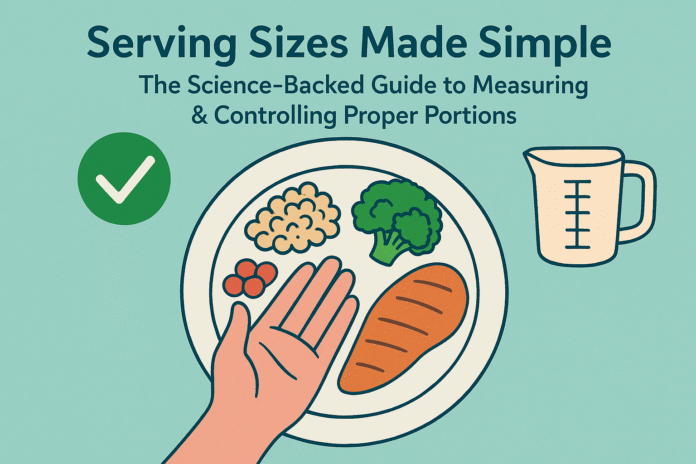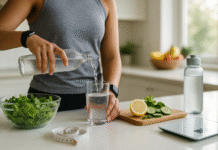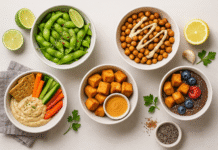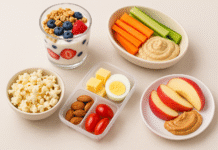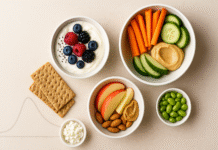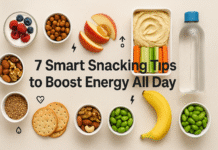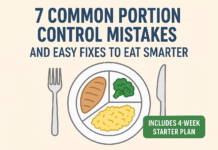Understanding serving sizes is more than counting calories — it’s about how our bodies, brains, and environments interact with food. This guide explains the science behind serving sizes, shows practical ways to measure and control portions, and gives realistic plans and tools you can use today. The primary topic — serving sizes and proper portions — is discussed in the first 100 words to ground this piece: serving size definitions, the “portion size effect” (how larger portions drive increased eating), labeling rules that shape what we see on packages, and practical tactics (plate methods, hand measures, scales) that help people eat in balance.
Disclaimer: This article provides evidence-based, general guidance on portion control and nutrition. It is not medical advice. For personal medical, dietary, or health conditions (including eating disorders), consult a qualified health professional before making significant changes.
Who this article is for: Anyone who wants practical, science-backed ways to understand and manage portion sizes — from busy professionals trying to eat more mindfully, to parents learning how to serve children appropriate amounts, to health coaches and nutrition beginners who want clear step-by-step plans.
What you’ll learn: what serving sizes and portions actually mean; the research behind why larger portions increase intake; how labels and packaging affect perception; precise, beginner-friendly ways to measure portions (tools, hands, and plates); sample mini-plans and a 4-week starter program to build sustainable portion control habits.
Key takeaways
- Serving size ≠ portion. Serving sizes are standardized amounts on labels; portions are the amount you actually choose to eat.
- Bigger portions make us eat more. Controlled experiments and meta-analyses show that increasing portion size reliably increases energy intake.
- Practical tools work. Measuring cups, a kitchen scale, hand-based rules, and plate-arrangements consistently help people reduce over-serving.
- Environment matters. Plate size, package size, and labeling shape “consumption norms” and can nudge how much we eat. Effects vary, but the evidence shows environmental cues are powerful.
- Small, sustainable changes beat extremes. Start with simple swaps — smaller plates, pre-portion snacks, more veggies — and track progress over weeks.
What are serving sizes and portions? Why the distinction matters
What it is and core benefits or purpose.
A serving size is a standardized amount used for nutrition labeling or dietary guidance; it’s meant to let people compare foods on a level playing field. A portion is the amount you actually choose to eat at one sitting — and it often differs from the serving size. Recognizing the distinction prevents under- or over-counting calories and nutrients and helps you make realistic, healthful choices. www.heart.org
Requirements / prerequisites / low-cost alternatives.
No equipment required to understand the distinction. For practical measurement, low-cost tools like measuring cups, spoons, and a kitchen scale are helpful but not mandatory — you can use hand-sized guides as alternatives.
Step-by-step: How to translate label serving sizes to real portions
- Check the Nutrition Facts: Look at the “serving size” at the top of the label. It lists how much the manufacturer considers a serving and how many servings are in the package.
- Compare to what you eat: If the package lists 1 serving as 1 cup and you pour 2 cups, you’ve eaten two servings. Multiply the calories and nutrients accordingly.
- Adjust for your needs: Serving sizes are averages — tailor portion amounts by your calorie needs, activity level, and health goals.
Beginner modifications and progressions.
- Beginner: Simply read labels and eyeball whether your portion is larger than a listed serving.
- Progression: Start measuring one meal per day for a week with cups/scale; then reduce to 2–3 times per week as you build an eye for portions.
Recommended frequency/duration/metrics.
- Practice checking labels and measuring at least once daily for two weeks to develop portion awareness. Use metrics like “percentage over/under label serving” or total calories per meal if tracking.
Safety, caveats, and common mistakes.
- Don’t equate serving size with a prescriptive target — it’s a tool. Over-focusing on labels can encourage obsessive behavior in people with a history of disordered eating. If you have concerns, consult a professional.
Mini-plan (2–3 steps)
- For one week, check the label serving size on all packaged snacks.
- If you usually eat a whole bag, portion out a labeled serving into a bowl before eating.
The portion-size effect: the evidence that size changes intake
What it is and core benefits or purpose.
The portion-size effect describes a robust pattern from experimental and field studies: people eat more when presented with larger portions. Understanding this effect gives us leverage — reduce served amounts and you often reduce intake, with minimal effort. Multiple systematic reviews and meta-analyses confirm this phenomenon across ages and settings.
Requirements/prerequisites and low-cost alternatives.
No equipment needed to benefit from this insight. The “requirement” is simply deciding to serve or purchase smaller portions (or to split servings). Low-cost alternative: buy smaller package sizes or pre-portion larger packages into single-serving containers.
Step-by-step implementation (apply the science at home)
- Measure baseline: For three days, note the amount (cup or grams if possible) you serve at each meal.
- Reduce by 10–20%: For the next two weeks, serve 10–20% less at meals — the reduction is often unnoticed but meaningful.
- Observe fullness: Track hunger/fullness on a simple scale 0–10 after meals to ensure satisfaction remains.
- Adjust portions upward for high-activity days.
Beginner modifications and progressions.
- Beginner: Reduce portion sizes only at dinner or for snack foods.
- Progression: Apply reductions to all meals and include portioning of mixed dishes.
Recommended frequency/duration/metrics.
Try this approach for 2–6 weeks while tracking average meal calories or plate volume. Use metrics like daily calories, number of servings of vegetables, or subjective fullness scores.
Safety, caveats, and common mistakes.
- Be careful not to under-eat if you have high energy needs (athletes, breastfeeding).
- Watch for compensatory behavior (eating more later because you’re too restrictive). If compensation occurs, adjust portion reductions to be smaller.
Mini-plan (2–3 steps)
- For snacks, pre-portion into small containers each Sunday (e.g., single-serving nuts).
- Use smaller plates for one week and note whether you feel hungry afterward — tweak if needed.
Evidence note: Multiple randomized trials and meta-analyses document that increasing portion size increases energy intake in adults and children; conversely, reducing portion size decreases intake and can reduce daily energy intake and body weight in controlled settings.
How serving sizes are set: labels, regulations, and what they mean for you
What it is and core benefits or purpose.
Regulatory agencies set standardized serving sizes (reference amounts) to make nutrition labels comparable across foods. Knowing how these are calculated helps you interpret labels and spot “portion distortion” where packaging suggests unrealistic portions.
Requirements/prerequisites and low-cost alternatives.
No equipment needed. Familiarize yourself with the label layout and the “servings per container” information.
Step-by-step: reading and using label serving sizes
- Find the serving size at the top of the Nutrition Facts panel.
- Note the servings per container. If a container lists multiple servings, don’t assume it’s a single serving.
- Multiply nutrients by how much you actually eat (e.g., label calories × number of servings you consume). Federal Register
Beginner modifications and progressions.
- Beginner: Use labels for packaged foods only.
- Progression: Apply to restaurant nutrition info and make portion swaps when eating out.
Recommended frequency/duration/metrics.
Read labels on new packaged foods; incorporate label-checking into weekly grocery habits.
Safety, caveats, and common mistakes.
- Bringing assumptions: packages marketed as “single-serve” may still contain multiple servings per the label. The agency guidance exists to standardize but not to recommend exact intake for individuals.
Visual and environmental cues: plates, packaging, and perception
What it is and core benefits or purpose.
Visual context — plate size, package size, and labeling words like “regular” or “large” — strongly influence how much we serve and perceive as appropriate. These cues create consumption norms and can increase intake without conscious awareness. Understanding this helps you design an eating environment that nudges mindful portions.
Requirements/prerequisites and low-cost alternatives.
No special equipment — only awareness and simple swaps: smaller plates, single-serve packaging, and pre-plated portions.
Step-by-step environmental changes to reduce over-serving
- Switch one plate size: Replace your largest dinner plate with a salad/salad-sized plate for everyday meals.
- Serve from the kitchen: Avoid family-style passing of platters; plate food in the kitchen so people serve smaller first helpings.
- Use opaque containers for snacks to avoid seeing the whole package while eating.
- Avoid “value packs” when you’re likely to eat the whole thing.
Beginner modifications and progressions.
- Beginner: Start by using a smaller plate at dinner.
- Progression: Change all dinnerware, and make food less visible on the table during meals (e.g., keep chips in the pantry).
Recommended frequency/duration/metrics.
Implement environmental changes for 4 weeks and measure average meal calories or how often you take seconds.
Safety, caveats, and common mistakes to avoid.
- The literature on plate size is mixed: some meta-analyses find substantial effects while other pre-registered trials find smaller or no effects. Use plate swaps as one of multiple strategies rather than a single fix.
Mini-plan (2–3 steps)
- For one week use a salad plate (<9 inches) at dinnertime.
- Keep snacks portioned in small, opaque containers.
Energy density and satiety: why different foods fill you differently
What it is and core benefits or purpose.
Energy density is calories per gram. Foods with low energy density (vegetables, broth-based soups) fill more volume for fewer calories, helping you feel full on smaller calorie totals. Choosing low-energy-dense staples while keeping small high-energy-dense treats is a strategic way to control portions and hunger.
Requirements/prerequisites and low-cost alternatives.
No equipment — just knowledge of food categories. Low-cost tactic: bulk up meals with vegetables or broth to increase volume without many extra calories.
Step-by-step to lower energy density at meals
- Fill half your plate with non-starchy vegetables (salad, steamed veggies).
- Use whole grains or legumes as the starchy component but keep portions moderate.
- Limit added fats and high-sugar sauces which spike energy density.
Beginner modifications and progressions.
- Beginner: Add one cup of vegetables to each main meal.
- Progression: Replace one starchy side each day with a vegetable side.
Recommended frequency/duration/metrics.
Daily practice; track “veg-first” meals per week or servings of vegetables/day.
Safety, caveats, and common mistakes.
- Some nutrient-dense foods (nuts, avocados) are healthy but calorie-dense. Portion them carefully.
Mini-plan (2–3 steps)
- Add a large side salad to dinner daily for one week.
- For snacks, pair a small high-calorie item (e.g., 1 oz nuts) with a cup of cut fruit or veggies.
Practical tools: cups, spoons, scales, and hand rules
What it is and core benefits or purpose.
Practical measurement tools help calibrate your eye, build accurate portion estimation, and remove guesswork. Commonly used tools include measuring cups/spoons, kitchen scales, and simple hand-based rules (palm = protein, fist = cup, thumb = fat). These are portable and can be used anywhere.
Requirements/prerequisites and low-cost alternatives.
- Essential: one set of measuring cups & spoons (cheap) and a basic digital kitchen scale (budget models are inexpensive).
- Alternative: hand-size method (no tools) — use your palm, fist, cupped hand, and thumb as proxies.
Step-by-step beginner guide to common measures
- Buy a kitchen scale if you cook often. Practice weighing typical foods: rice, chicken breast, cheese.
- Use measuring cups for pasta, cereals, and liquids when learning.
- Practice hand rules: palm-sized protein (~3–4 oz), fist-sized carb (~1 cup), two cupped hands for a portion of cooked pasta/rice, thumb for fats (~1 tbsp).
Beginner modifications and progressions.
- Beginner: Measure snacks once per day to calibrate how much you naturally eat.
- Progression: Weigh and log one meal daily for a week, then switch to visual estimating.
Recommended frequency/duration/metrics.
Use tools daily for 2 weeks to develop accuracy, then use them weekly for maintenance. Metrics: grams of protein/carbs/fat per meal or number of servings per day.
Safety, caveats, and common mistakes.
- Don’t stress accuracy to the point it disrupts life. The goal is reasonable, sustainable portion control.
- People with a history of disordered eating should consult a professional before rigorous weighing or logging.
Mini-plan (2–3 steps)
- Buy (or borrow) a basic kitchen scale. Weigh one portion of your usual breakfast for three days.
- Compare the measured portion to the package label serving (if available).
Portioning by food group: practical serving guides and quick how-tos
This section gives concrete serving sizes and how to measure them for major food groups. Where specific numbers are used, they reflect standardized guidance for typical adult reference diets — adjust for age, sex, and activity.
Vegetables and fruits
What it is and core benefits or purpose.
High-volume, low-energy-density foods that increase fullness and micronutrient intake.
Typical serving definitions & tools:
- 1 serving vegetables: ~1 cup raw leafy greens or 1/2 cup cooked vegetables.
- 1 serving fruit: ~1 cup fresh fruit or 1/2 cup canned/frozen/dried per the standard guide.
How to implement (step-by-step):
- Fill half your plate with vegetables at lunch/dinner.
- Pre-cut fruit into 1-cup portions for snacks.
Beginner modifications and progressions:
- Add one extra cup of veggies per day, then increase to two.
Recommended frequency/duration/metrics:
Aim for 5+ servings (combined) of fruits and vegetables daily; most adults should try for at least 2–3 cups of vegetables and 1.5–2 cups of fruit depending on calorie needs.
Safety and mistakes:
- Fruit juices concentrate sugar with less fiber — prefer whole fruit.
Mini-plan (2 steps):
- Add a cup of vegetables at dinner every day for one week.
- Swap afternoon processed snack for one cup of fruit.
Grains and starchy carbs
What it is and core benefits or purpose.
Primary energy source; choose whole grains for fiber and satiety.
Typical serving definitions & tools:
- 1 serving grain (refined/whole): ~1 ounce equivalent — about 1 slice of bread, 1/2 cup cooked rice/pasta/cereal.
How to implement:
- Use measuring cups to serve 1/2 cup cooked rice/pasta as a standard portion.
- For bread, count slices.
Beginner modifications and progressions:
- Beginner: Limit starchy sides to 1/2–1 cup per meal.
- Progression: Swap half the portion for vegetables.
Recommended frequency/duration/metrics:
Track grain servings per day; typical suggested ranges vary by calorie needs (2–8 oz equivalents/day depending on diet level).
Mini-plan (2 steps):
- Measure your usual pasta serving once. If it’s >1 cup cooked, reduce to 1/2–3/4 cup and add a vegetable side.
Protein foods (meat, fish, eggs, legumes)
What it is and core benefits or purpose.
Protein supports repair, muscle maintenance, and satiety.
Typical serving definitions & tools:
- Meat/fish/poultry: ~3 oz cooked (about the size of a palm) per serving.
- Plant proteins: 1/2 cup cooked beans ≈ 1 serving.
How to implement:
- Use your palm to estimate a 3–4 oz cooked protein portion.
- For legumes, measure 1/2 cup cooked.
Beginner modifications and progressions:
- Beginner: Aim for palm-sized protein at two meals/day.
- Progression: Add leaner cuts or more plant-based proteins if desired.
Mini-plan (2 steps):
- Serve a palm-sized piece of protein at dinner.
- Add a double-handful of vegetables to the plate.
Fats and oils
What it is and core benefits or purpose.
Calorie-dense but essential in small amounts (flavor, absorption of fat-soluble vitamins).
Typical serving definitions & tools:
- 1 serving fat: about 1 tablespoon (e.g., oil, butter), or a thumb-sized amount of nut butter.
How to implement:
- Measure cooking oil with a tablespoon until you can eyeball it.
- When eating fats like nut butter, portion into 1-tablespoon servings.
Mini-plan (2 steps):
- Use one tablespoon of oil for sautéing vegetables and measure it the first week.
- For snacks, pre-portion nut butter into tablespoon servings.
Beginner-friendly step-by-step program: 4-week starter plan
Purpose: Start building portion awareness and habits gradually so changes last.
Week 1 — Awareness (Establish measurement habits)
- Goals: Measure one meal per day; read labels on packaged foods; pre-portion snacks.
- Actions: Buy a kitchen scale or measuring cups. For seven days, measure your breakfast or snack; log the serving size vs. what you usually ate.
Week 2 — Simple swaps (Environment and volume)
- Goals: Use smaller plates at dinner; add one cup of vegetables to one meal each day.
- Actions: Replace the largest dinner plate with a salad plate for at least dinner. Keep snacks out of sight and pre-portioned.
Week 3 — Portion balancing (macros and satiety)
- Goals: Apply hand-sized portion method for protein/starch/fat at two meals.
- Actions: Protein = palm, starch = fist (1/2 cup cooked), fat = thumb; fill remainder with vegetables. Track fullness on a 0–10 scale post-meal.
Week 4 — Fine-tuning & tracking
- Goals: Reduce portion size of high-calorie items by another 5–10% if desired; reflect on which changes were sustainable.
- Actions: Weigh a typical meal and compare to Week 1. Continue environmental strategies and pre-portioning. Consider a weekly weigh-in or photo log to observe changes.
Metrics to track: number of pre-portioned snacks per week, vegetable cups/day, subjective fullness, and weight (if weight change is a goal). Use these metrics weekly, not daily, to avoid overreacting to natural variation.
Troubleshooting: common pitfalls and how to fix them
Pitfall 1 — Feeling unsatisfied after shrinking portions
- Fix: Keep volume high with vegetables/soup, add a source of protein or fiber to the meal, and don’t cut portions on high-activity days.
Pitfall 2 — Eating from package/bag mindlessly
- Fix: Always pre-portion into a bowl or container; don’t eat straight from the bag.
Pitfall 3 — Over-reliance on labels when eating out
- Fix: Order smaller sizes, share dishes, or immediately box half before eating.
Pitfall 4 — Conflicting plate-size advice
- Fix: Use a combined approach — environmental nudges (smaller plates) plus measuring tools and mindful eating rather than relying solely on one tactic.
Measuring progress: what to watch and when to adjust
What to measure: subjective fullness, number of vegetable servings/day, frequency of pre-portioned snacks, and for weight-related goals — weekly weight or body measurements.
How often: track subjective measures daily if you like, but check objective metrics (weight, measurements) weekly to avoid overreacting to daily noise.
When to adjust: If you consistently feel hungry, increase portions slightly or add more protein/vegetables. If progress stalls for several weeks, reassess total daily calories and activity.
Safety, special populations, and caveats
- Children: Serve smaller, age-appropriate portions and avoid pressuring kids to “clean the plate”; let them self-regulate hunger cues. Use hand-based or child-sized plate guides for serving. nhs.uk
- Athletes and highly active people: Require larger portions and more frequent meals — tailor portions to training load.
- Eating disorders: People with a history of disordered eating should avoid rigid weighing or obsessive tracking; seek support from clinicians.
- Medical conditions: Those with diabetes, kidney disease, or other medical conditions should consult a professional for tailored portion guidance.
FAQs
- What’s the difference between a serving size and a portion?
A serving size is the standardized amount on a label or guideline; a portion is how much you actually eat at a sitting. Use labels to compare foods, but tailor portions to your needs. - Do smaller plates really make you eat less?
Evidence is mixed. Many studies show smaller plates can reduce the amount people serve themselves, especially when self-serving; other well-controlled trials find smaller or no effects. Use plate size as one tool alongside measuring and mindful habits. - How can I estimate portions without a scale?
Use hand-based measures: palm = protein (3–4 oz), fist = 1 cup (starch/veg), cupped hand = snack portion, thumb = tablespoon (fat). Practice comparing these to measured portions to calibrate your eye. - Are serving sizes on labels accurate for everyone?
Serving sizes are averages set by regulatory guidance. Individual calorie needs vary by age, sex, and activity — use serving sizes as a comparison tool, not a rigid prescription. - Will reducing portions make me feel hungry all the time?
Not necessarily. Increasing low-energy-density foods (vegetables, broth-based soups), adding protein, and spacing meals sensibly can maintain fullness while reducing calories. - What are easy swaps to reduce portion-driven overeating?
Use smaller plates, pre-portion snacks, buy smaller packages, and fill half your plate with vegetables. These small changes add up. - Is portion control effective for weight loss?
Yes, reducing portion sizes can reduce daily energy intake and support weight loss when combined with good food choices and activity. Controlled studies and meta-analyses support the principle. - How do I portion foods for children?
Serve smaller, child-sized portions and avoid insisting they clear their plates. Use age-appropriate hand and plate guides and offer second helpings if the child is still hungry. - Can I still enjoy treats?
Absolutely. Pre-portion treats (e.g., one small dessert or a single-serve chocolate) and savor them mindfully. The goal is balance, not elimination. - How long until I notice results?
Behavioral changes show subjective benefits (less bloating, better satiety) quickly — measurable weight changes vary by individual. For habit formation, aim for consistent practice over 4–8 weeks. MDPI - Are there apps to help with portion control?
Yes — many apps allow you to log food, track serving sizes, and compare to labels. Use them as training wheels, then rely more on skills you build. - How much should I adjust serving sizes for exercise days?
Increase portions for carbohydrate and protein on high-activity days to support performance and recovery. Track energy and performance outcomes rather than just portion sizes.
Final checklist: Quick-start portion-control checklist
- Buy a basic kitchen scale or measuring cups.
- Swap one dinner plate to a salad plate for a week. SPARQ
- Pre-portion snacks into small opaque containers each Sunday. lovefoodhatewaste.com
- Fill half your plate with vegetables at lunch/dinner. MyPlate
- Use the hand guide for proteins (palm), carbs (fist), and fats (thumb).
Conclusion
Serving sizes are both a technical label and a behavioral lever. When you learn how labels are set, why environment and plate size influence our choices, and how to use simple tools (scales, cups, hands), you gain practical control over portions without stress. Start small: measure, swap a plate, portion your snacks, and add vegetables. Over weeks those tiny changes compound into a new normal — one where your portions match your goals, hunger cues, and lifestyle.
Call to action (one-line, copy-ready): Try the 4-week starter plan above and notice one measurable change in how you feel at the end of week four.
References
- Systematic Review and Meta-Analysis on the Effect of Portion Size on Energy Intake and Body Weight — National Library of Medicine (PMC). Publication: 2022. URL: https://www.ncbi.nlm.nih.gov/pmc/articles/PMC8803498/ PMC
- Downsizing food: a systematic review and meta-analysis examining the effect of reducing served food portion sizes on daily energy intake and body weight — National Library of Medicine (PMC). Publication: 2023. URL: https://www.ncbi.nlm.nih.gov/pmc/articles/PMC9975786/ PMC
- The Contribution of Expanding Portion Sizes to the US Obesity Epidemic — American Journal of Public Health (AJPH). Publication: 2002. URL: https://www.ncbi.nlm.nih.gov/pmc/articles/PMC1447051/ PMC
- What Is MyPlate? (MyPlate overview and recommendations) — MyPlate (USDA). Accessed 2024. URL: . MyPlate
- Food Portions: Choosing Just Enough for You — National Institute of Diabetes and Digestive and Kidney Diseases (NIDDK). Updated 2024/2025. URL: . NIDDK
- Guidance for Industry: Reference Amounts Customarily Consumed (RACC) — U.S. Food & Drug Administration (FDA) (guidance PDF). Publication: 2016. URL: . U.S. Food and Drug Administration
- Serving Sizes of Foods That Can Reasonably Be Consumed at One Eating Occasion — Final Rule and Guidance — U.S. Food & Drug Administration (FDA) (PDF). Publication: 2016/2019 guidance. URL: . U.S. Food and Drug Administration
- Portion Size: What We Know and What We Need to Know — National Library of Medicine (PMC). Publication: 2015 (review). URL: https://www.ncbi.nlm.nih.gov/pmc/articles/PMC4337741/ . PMC
- How plate size affects food serving and intake (meta-analyses and pre-registered studies) — including the plate-size meta-analysis and pre-registered experimental study (International Journal of Behavioral Nutrition and Physical Activity). Publications: 2016–2019. Representative links:
- Meta-analysis summary: . SSRN
- Pre-registered experimental study: . BioMed Central
- Plate-size induced consumption norms — field and lab evidence — Journal of the Association for Consumer Research / Cornell coverage. Publication: 2013 (study/news). URL: . Cornell Chronicle
- 9 Tips to Measure and Control Portion Sizes — Healthline. Updated 2024. URL: . Healthline
- Measuring Portions — How much am I really eating? — Clemson University Home & Garden Information Center (HGIC). Educational fact sheet (measuring cups, scales, tips). URL: . Home & Garden Information Center
- Hand portion guide (A4 document) — NHS / UK localized guidance (PDF). Publication: 2022. URL: . Leicestershire Partnership NHS Trust
- Portion sizes — British Nutrition Foundation / BNF guidance on portion sizes — BNF/Nutrition.org.uk. URL: . British Nutrition Foundation




























